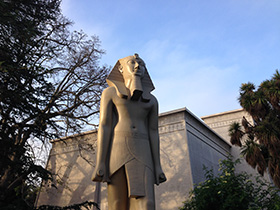New Kingdom Rulers
- Neolithic Period: 4500-3000 BCE
- Early Dynastic: 3000-2650 BCE
- Old Kingdom: 2650-2150 BCE
- 1st Intermediate Period: 2150-2040 BCE
- Middle Kingdom: 2040-1640 BCE
- 2nd Intermediate Period: 1640-1550 BCE
- New Kingdom: 1550-1070 BCE
- - Architects: Amenhotep, Son of Hapu
- - Architects: Senenmut
- - Rulers: Amenhotep III
- - Rulers: Amenhotep IV
- - Rulers: Hatshepsut
- - Rulers: Ramses II
- - Rulers: Ramses III
- - Rulers: Thutmose III
- - Rulers: Tutankhamun
- - Monuments: Abu-Simbel
- - Monuments: Abydos - The Temple of Seti
- - Monuments: Akhetaton (Tell el-Amarna)
- - Monuments: Amenhotep III’s Mortuary Complex
- - Monuments: Deir-el-Bahri
- - Monuments: Luxor Temple
- - Artifacts: Link to Collection Search
- 3rd Intermediate Period: 1070-712 BCE
- Saite and Late Periods: 712-332 BCE
- Greco-Roman Period: 332 BCE-642 CE
- Coptic Period: 395-642 CE
- Islamic Period and Modern Times: 642 CE-Today
- Neolithic Period: 4500-3000 BCE
- Early Dynastic: 3000-2650 BCE
- Old Kingdom: 2650-2150 BCE
- 1st Intermediate Period: 2150-2040 BCE
- Middle Kingdom: 2040-1640 BCE
- 2nd Intermediate Period: 1640-1550 BCE
- New Kingdom: 1550-1070 BCE
- - Architects: Amenhotep, Son of Hapu
- - Architects: Senenmut
- - Rulers: Amenhotep III
- - Rulers: Amenhotep IV
- - Rulers: Hatshepsut
- - Rulers: Ramses II
- - Rulers: Ramses III
- - Rulers: Thutmose III
- - Rulers: Tutankhamun
- - Monuments: Abu-Simbel
- - Monuments: Abydos - The Temple of Seti
- - Monuments: Akhetaton (Tell el-Amarna)
- - Monuments: Amenhotep III’s Mortuary Complex
- - Monuments: Deir-el-Bahri
- - Monuments: Luxor Temple
- - Artifacts: Link to Collection Search
- 3rd Intermediate Period: 1070-712 BCE
- Saite and Late Periods: 712-332 BCE
- Greco-Roman Period: 332 BCE-642 CE
- Coptic Period: 395-642 CE
- Islamic Period and Modern Times: 642 CE-Today
Thutmose III
1482 BCE – 1425 BCE
A ruler during the New Kingdom’s Eighteenth Dynasty, Thutmose III expanded Egypt’s borders to their furthest extent, conquering more land than any pharaoh before or after him. He was the son of Thutmose II by a minor wife named Iset. When Thutmose II died, his chief wife and half-sister, Hatshepsut, became Thutmose III’s regent. However, she did not step down when Thutmose III came of age. Instead, she made him a joint pharaoh with her and continued to rule the country herself.
During this time, Thutmose III was made head of Egypt’s armies. In the twenty-third year of his reign (his second year as the sole pharaoh), he led a successful military expedition into Syria and Palestine. He went on to defeat the King of Mitanni in battle and pushed Egypt’s southern border to the fourth cataract of the Nile.
At home, Thutmose III built many temples, including the Festival Hall and Seventh Pylon at Karnak and his own mortuary temple at Deir-el-Bahri. Though he is often blamed for the destruction of his stepmother Hatshepsut’s images, others have argued that Thutmose III’s son, Amenhotep III, may have destroyed them during his reign in order to delegitimize any claim to the throne by Hatshepsut’s children (who, as the offspring of a pharaoh, had as much right to the throne as he did).
In addition to serving as pharaoh, Thutmose III directed the mystery school at Karnak and organized the mystery schools together as a single Order.

Image: Thutmose III statue at Rosicrucian Park
Armstrong, Steven. “Hidden Harmonies: Discovering the Egyptian Foundations of the Rosicrucian Path.” Rosicrucian Digest, Volume 85, No. 1. 2007.
David, Anthony and Rosalie. A Biographical Dictionary of Ancient Egypt. London: Taylor & Francis, 1992.
Lehner, Mark and Richard H. Wilkinson. The Complete Pyramids: Solving the Ancient Mysteries. London: Thames & Hudson, 1997.
http://www.pbs.org/empires/egypt/newkingdom/tuthmosis3.html

